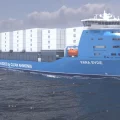DB Schenker publishes new key environmental figures: emissions in the Rail and Logistics Business Units continue to fall as efficiency has increased further
 Munich/Berlin, June 4, 2013 – DB Schenker has just published its 2013 Environment Brochure. The brochure uses current key figures and examples to document the results of efforts to improve climate protection on the rails, on the road, in the air and in the ocean and in contract logistics. This is already the third time that DB’s Transportation and Logistics Division has published its key environmental figures.
Munich/Berlin, June 4, 2013 – DB Schenker has just published its 2013 Environment Brochure. The brochure uses current key figures and examples to document the results of efforts to improve climate protection on the rails, on the road, in the air and in the ocean and in contract logistics. This is already the third time that DB’s Transportation and Logistics Division has published its key environmental figures.
“As a multinational logistics company, we want to be a pioneer in the use of low-emission technology and in the development of resource-saving processes. We have set out to become a pioneer in environmental protection by 2020 and reduce our specific CO2 emissions by 20 percent compared to 2006 levels. We have already made considerable cuts in our specific CO2 emissions thanks to a variety of measures,” said Dr. Karl-Friedrich Rausch, Member of the Management Board of DB Mobility Logistics AG responsible for Transportation and Logistics and Chief Sustainability Officer of the DB Group.
The DB Schenker Rail Business Unit, for example, has already succeeded in reducing its specific CO2 emissions by 14 percent of 2006 levels. DB Schenker Logistics has cut CO2 per metric ton kilometer in ocean freight by 33 percent since 2006. And the use of slow steaming has generated savings of roughly 12 percent just since last year. Specific CO2 emissions from land transport fell around 11 percent thanks to the use of new vehicles and better capacity utilization. The brochure also documents pollutants such as sulfur oxide, nitrogen oxide, particulate matter and hydrocarbons.
DB Schenker sets standards with environmentally products and the efficient use of natural resources. It earned a Silver certificate from the German Sustainable Building Council (DGNB) for green and economical construction of its new logistics center in Augsburg, Germany. In Sweden DB Schenker put the first trucks powered by frozen biogas into operation.
Since 2012, DB Schenker Rail has been using Europe’s first hybrid switching locomotives as well as 100 Gravita switching locomotives equipped with additional soot particle filters. DB Schenker Rail invested approximately 240 million euros in the new fleet of diesel locomotives, ten million of which was invested in the special filters alone. According to the manufacturer’s specifications, these filters remove 97 percent of soot particles. “Green Days” have been held at DB Schenker Logistics branches worldwide since 2012 to firmly establish environmental consciousness in the Group. They have already taken place in Indonesia, in Mexico and at the headquarters in Essen.
DB Schenker offers its customers climate-friendly transportation and logistics solutions through its Eco Solutions program – from CO2-free rail freight transports and reduced CO2 logistics products to products that let customers neutralize their CO2 emissions by investing in climate protection programs.
Recording CO2 emissions along the entire supply chain is one of the major challenges in transportation and logistics that DB Schenker has set out to overcome with its EcoTransIT World tool and its commitment to harmonization initiatives. The tool uses parameters from the transportation industry and DB Schenker suppliers and carriers, which are reviewed each year, to analyze CO2 emissions along the entire transportation chain (www.ecotransit.org).
The 2013 Environment Brochure from DB Schenker is available for download at www.dbschenker.com/environment
SOURCE: Submitted by DB Schenker





